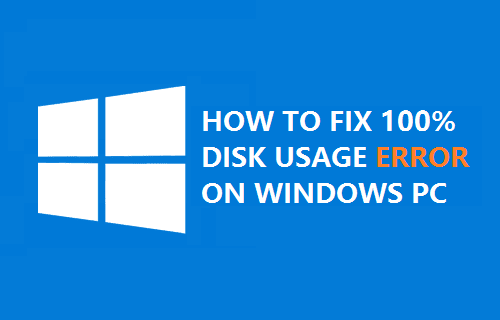It’s likely that you’re dealing with High Disk Usage on your computer if it’s gotten painfully slow, freezes, or hangs up frequently. The steps to repair 100% Disk Usage in Windows 10 are listed below.
Fix 100% Disk Usage in Windows 10
Even if you only have a few programs open on your computer, 100% Disk Usage in Windows 10 usually results in a frustratingly slow machine. Right-click the Start button and select Task Manager from the WinX menu to confirm.
Switch to the Processes tab on the Task Manager Screen and look at the Disk column. If your computer’s resource usage is maxed out and the Disk column is red with High Disk Usage (88 to 100 percent), you need to take corrective action.
1. Turn on the computer
Restarting a Windows machine is the simplest technique to reduce high disc usage. This will end all running programs and processes that were consuming all of your computer’s resources. While this is only a temporary solution, it will make it easier for you to use the computer while you work on other ways to reduce disc usage and fix 100% Disk Usage in Windows 10.
2. Stop Skype from being used in the background
If you have Skype installed on your computer, be sure that the Skype App or Skype Desktop Program does not start automatically and consumes resources by operating in the background.
3. Turn off Tips, Tricks, and Suggestions
- Some users have reported that the “Get Tips, Tricks, and Suggestions” function in Windows 10 causes their computers to slow down.
- Disable notifications and actions in Settings > System > Notifications & actions.
- Option to receive tips, tricks, and recommendations.
- If you restart your computer, you could notice that it runs faster than before.
4. In Chrome, turn off page preloading
Chrome is infamous for consuming a lot of resources, and disabling the preloading of web pages is a simple approach to reduce Chrome’s usage.
- Open Chrome Browser > Select Settings from the drop-down menu by clicking the three dots icon.
- Scroll down to the “Privacy & Security” section of the Chrome Settings page and select Cookies and other site data.
- Move the toggle next to Preload pages for faster browsing and searches to the OFF position on the following screen.
5. Modify File Explorer Preferences
Open File Explorer, then go to the View tab, then to the Options tab, then to the Change Folder and Search Options drop-down menu.
- Switch to the Search tab on the following screen and deselect
- Options to not utilize an index, include compressed files, and always search file names are available.
- To save this setting on your computer, click OK.
6. Turn off Windows’ search engine
Windows Search can eat up a lot of system resources, especially if it runs in the background or in a search loop. Expand Microsoft Windows Search Indexer in Task Manager, then right-click on Windows Search and select Stop. If you see that your disc usage percentage decreases after removing Windows Search, you may choose to disable Windows Search permanently to fix 100% Disk Usage in Windows 10.
7. Turn off Windows Search
- Right-click the Start button and select Run from the menu.
- Type services.msc in the Run command window and click OK.
- Right-click Windows Search and select Properties on the following screen.
- Set Startup Type to Disabled on the Windows Search Properties page.
- To save these changes to your computer, click Apply and OK.
8. Turn off the SuperFetch service
While the Windows SuperFetch Service can improve the performance of some apps on your computer, it is linked to high disc usage and has been known to cause issues on older and budget machines with 4 GB of RAM or less.
- Open Run Command, then type services.msc and hit Enter.
- Right-click SuperFetch and select Properties on the next screen.
- Set the Startup type to Disabled on the SuperFetch properties panel.
- To save this setting on your computer, click OK.
9. Modify the settings for virtual memory management
- Right-click This PC and select Properties from the drop-down menu.
- Select Advanced system settings on the next screen.
- Switch to the Advanced tab on the System Properties screen and click the Settings button under the “Performance” section.
- Switch to the Advanced tab on the Performance Options screen and click the Change button under the “Virtual Memory” section.
Uncheck the Automatically Manage option on the next screen, then select the System Managed Size and click OK. Make sure to restart your computer for the aforementioned modifications to take effect and fix 100% Disk Usage in Windows 10.
10. In the StorAHCI.sys Driver, disable MSI Mode
If you have a Windows 10 PC with an SSD drive and you’re seeing 100% Disk Usage in Windows 10, it could be due to a firmware bug that inhibits SSD devices from completing input/output requests.
- Right-click the Start button and select the Device Manager from the menu.
- Expand IDE ATA/ATAPI controllers on the Device Manager panel, then right-click on Standard SATA AHCI Controller and select Properties.
- Switch to the Driver tab on the following screen and select Driver Details.
If the storachi.sys entry appears in the Driver Details screen, you must disable MS Mode for the Driver using the Registry Editor patch described on Microsoft’s support page.
11. Virus and Malware Scanning
The presence of viruses and malware on a computer can result in a range of issues, including the fix 100% Disk Usage in Windows 10 Error. As a result, ensure your computer’s antivirus software is up to date. Use the free Microsoft Safety Scanner to scan your machine for malware and undo any changes made by malicious software.
12. Check for Errors on the Hard Drive
- Select PowerShell Admin or (Command Prompt Admin) from the Start menu by right-clicking.
- Type chkdsk.exe /f /r in the PowerShell window and click Enter on your computer’s keyboard.
- If you’re asked if you want the volume to be checked on the next restart, select Y.
Close the PowerShell window, restart your computer, and wait for Windows to check for faults and repair damaged sectors on your hard drive (if any).



